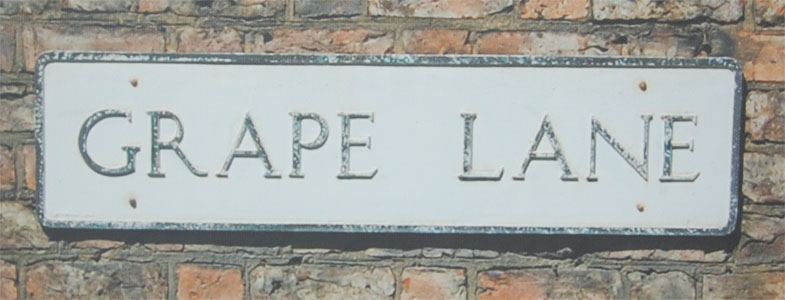Outrageous British Street Names June 8, 2010
Author: Beach Combing | in : Medieval, Modern , trackback
Be warned! This entry in Beachcombing’s encyclopaedia of the damned is not about British streets that happen to sound rude: Booty Lane (York), Percy’s Passage (London) etc etc etc. Rather it is about British street names that reflect our ancestors’ remarkable lack of embarrassment about the toilet and the bedroom and that have survived through to primmer times.
Beachcombing became interested in this phenomenon while reading a curious work that a book-dealer friend, Dray, sent him: The Orrible Synne: A Look at London Lechery from Roman to Cromwellian Times (London 1973) by E. J. Burford. There was still a reviewer’s slip in The Orrible Synne when Beachcombing began reading. The reviewer’s slip carried the imperative message ‘[w]e would appreciate receiving two copies of the review when it appears in your journal’. How things have changed…Today a publishing house CEO would personally give an editor of ‘your journal’ a foot massage for a review, but that’s another story…
In a chapter on ‘Schetyng-pannes and syphilis’ Beachcombing came across this short passage (pp. 151-152): .
‘When London was comparatively rural, sanitation was a simpler matter. The people defecated or urinated in their gardens and thought nothing of it: but after the Norman Conquest when the township began to develop mightily, problems of sanitation arose that never existed before. Naturally old habits were hard to break, and when gardens were fewer, easements were done in the lanes and alleys. The consequent stench and obstructions were casually referred to as Pissing Lane, Stynkyng Alley, Shiteburnlane or Foul Lane. If the lane were additionally used for fornication it might also bear a suitable title such as Gropecuntlane – assuredly a hark-back to Saxon times – or Codpiece Alley, or even Whores Lie Down. These places, as may be expected, eventually were deodorized into Grape Lane, Coppice Alley and Horsleydown. Where there were Whorehouses, the streets would bear names like Whores Nest or Sluts’ Hole or Mayden Lane (in which there were no maidens at all) or Rose Alley (to pluck the roses of maidenheads) or Golden Lane, whence gold could be so earned.’
It was after reading this passage that Beachcombing noticed that no one had reviewed The Orrible Synne despite that imperative note…
So how well documented is all this? Well, pulling down Adrian Room’s The Street Names of England (Stamford 1992) – AR is an authentic WANW* – Beachcombing found a more convincing and better documented passage concerning the sexual side of Mr Burford’s thesis: pp. 48-49:
‘Love Lane is a common street name relating to a more universal diversion. Towns and cities with such a street include Chester, Loughborough (Lei), Pinner, northwest London, Salisbury (Wil), Sheffield (SYo), Stepney, east London and Weymouth (Dor). The name usually dates from the 16th or 17th century, and apart from the obvious activity also implied a street that was dark or dangerous. Maiden Lane or Maiden Street usually refers more explicitly to prostitutes, and is likewise found in several towns, including London, Nottingham and Stamford… [AR goes on to note how some instances of ‘Maiden’ are innocent] Finkle Street is now believed to have approximately the same connotations as Love Lane… It is found in many northern towns, including Carlisle (Cum), Kendal (Cum), Knaresborough (NYo), Lincoln (formerly), Ripon (NYo), Pontefract (WYo), Workington (Cum) and York. Norwich, too, has its Finkelgate. Most toponymists are now inclined to accept the origin proposed by Eilert Ekwall in Etymological Notes on English Place-Names (1959), where he derives the name from a conjectural Middle English word finkle meaning ‘to pet’, ‘to cuddle’. The oldest and most explicit of all street names of this type has survived in Grope Lane, Bristol, Grape Lane, York and Grape Passage, Reading (Ber). The name is a euphemistic short form of Gropecuntelane, and this (or a form of it) was formerly found in several towns. York’s Grape Lane was thus Grapecuntlane in the fourteenth century, while a hundred years earlier the City of London had its Gropecontelane and Oxford its Cropecuntelane. The ‘four letter word’ that lies at the heart of name is given its earliest citation by the Oxford English Dictionary (which admitted it to its pages only in 1972) from its occurrence in the Oxford street name, which dates back from about 1230. The street in that city that bore it is now Magpie Lane. Grope here relates to feeling one’s way in the darkness of the lane as much as to any physical amorous advances.’
Yeah right…
Beachcombing would be most grateful for further outrageous British street names that have survived or that were extinguished by our priggish Victorian and Edwardian forebears. [drbeachcombing[AT]yahoo[DOT]com]. There will also, he is sure, be plenty of examples from other countries…
* WANW = ‘We are not worthy’



